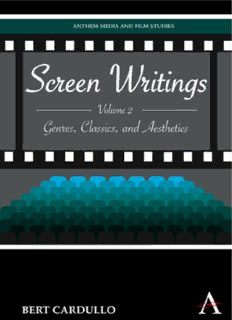
Screen Writings: Genres, Classics, and Aesthetics PDF
Preview Screen Writings: Genres, Classics, and Aesthetics
SCREEN WRITINGS SCREEN WRITINGS Genres, Classics, and Aesthetics Volume II Bert Cardullo Anthem Press An imprint of Wimbledon Publishing Company www.anthempress.com This edition first published in UK and USA 2010 by ANTHEM PRESS 75-76 Blackfriars Road, London SE1 8HA, UK or PO Box 9779, London SW19 7ZG, UK and 244 Madison Ave. #116, New York, NY 10016, USA Copyright © Bert Cardullo 2010 The author asserts the moral right to be identified as the author of this work. All rights reserved. Without limiting the rights under copyright reserved above, no part of this publication may be reproduced, stored or introduced into a retrieval system, or transmitted, in any form or by any means (electronic, mechanical, photocopying, recording or otherwise), without the prior written permission of both the copyright owner and the above publisher of this book. British Library Cataloguing in Publication Data A catalogue record for this book is available from the British Library. Library of Congress Cataloging in Publication Data A catalog record for this book has been requested. ISBN-13: 978 184331 837 8 (Hbk) ISBN-10: 1 84331 837 7 (Hbk) ISBN-13: 978 1 84331 879 8 (eBook) ISBN-10: 1 84331 879 2 (eBook) Table of Contents List of Illustrations vii Introduction: The Film of Value ix Part I. Film Genres, Film Classics, and Film Aesthetics 1 1. Shooting the City: The Gangster, Manhattanites, and the Movies 3 (on Paul Mazursky’s Next Stop, Greenwich Village, Martin Scorsese’s Taxi Driver, John Badham’s Saturday Night Fever, Neil Simon’s The Goodbye Girl, and Woody Allen Manhattan) 2. Back to the Future, or the Vanguard Meets the Rearguard 23 (on Gus Van Sant’s Last Days, Jun Ichikawa’s Tony Takitani, Kim Ki-duk’s 3-Iron, Michel Gondry’s Eternal Sunshine of the Spotless Mind, and Miranda July’s Me and You and Everyone We Know) 3. Flags and Letters, Men and War 49 (on Clint Eastwood’s Flags of Our Fathers and Letters from Iwo Jima) 4. Farce, Dreams, and Desire: Some Like It Hot Re-viewed 61 Interlude 71 5. Switching Genres, or Playing to the Camera, Playing to the House: Stage vs. Screen Acting 73 vi TABLEOFCONTENTS 6. On the Road Again: The Road Film and the Two Coppolas 87 (on Sophia Coppola’s Lost in Translation and Francis Ford Coppola’s The Rain People) 7. The Coming-of-Age Film à la Fellini: The Case of I vitelloni 103 Part II. Classification, Re-classification, and Assessment 113 8. Early vs. Later Bergman: Winter Lightand Autumn SonataRevisited 115 9. “Everyone Has His Reasons”: Words, Images, and La grande illusion in the Cinema of Jean Renoir 127 10. A Passage to Tokyo: The Art of Ozu, Remembered 149 (on Tokyo Story) 11. Through the Looking Glass: The American Art Cinema in an Age of Social Change 161 Bibliography of Related Criticism 173 Index 177 List of Illustrations 1. Next Stop, Greenwich Village 2. Saturday Night Fever 3. Tony Takitani 4. Eternal Sunshine of the Spotless Mind 5. Flags of Our Fathers 6. Some Like It Hot 7. The Rain People 8. Winter Light 9. La grande illusion 10. Bonnie and Clyde 11. Midnight Cowboy 12. The Graduate Introduction The Film of Value Throughout history, two factors have formed people’s taste in any art, their valuing of it, that is: knowledge of that art and knowledge of life. Obviously this is still true, but the function of taste seems to be altering. As formalist aesthetic canons have come to seem less and less tenable, standards in art and life have become more and more congruent, and as a result the function of taste is increasingly the selection and appraisal of the works that are most valuable to the individual’s very existence. So our means for evaluating films naturally become more and more involved with our means for evaluating experience; aesthetic standards don’t become identical with standards in life but they are certainly related – and, one hopes, somewhat braver. Of course the whole process means that human beings feed on themselves, on their own lives variously rearranged by art, as a source of values. But despite other prevalent beliefs about the past connected with theology and religion, we are coming to see that people have always been the source of their own values. In the century in which this responsibility, this liberation, became increasingly apparent – the twentieth – the intellect of man simultaneously provided a new art form, the film, to make the most of it. That art form is obviously still with us, and now, in the twenty-first century, more than ever, it seems. And its critics proliferate in number, in part because of what I describe above: the “personal” element involved in the watching of any movie, and the ease nowadays with
Description: